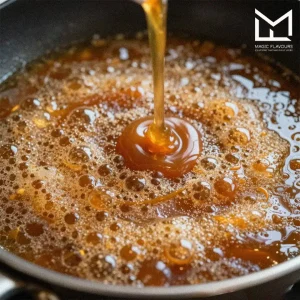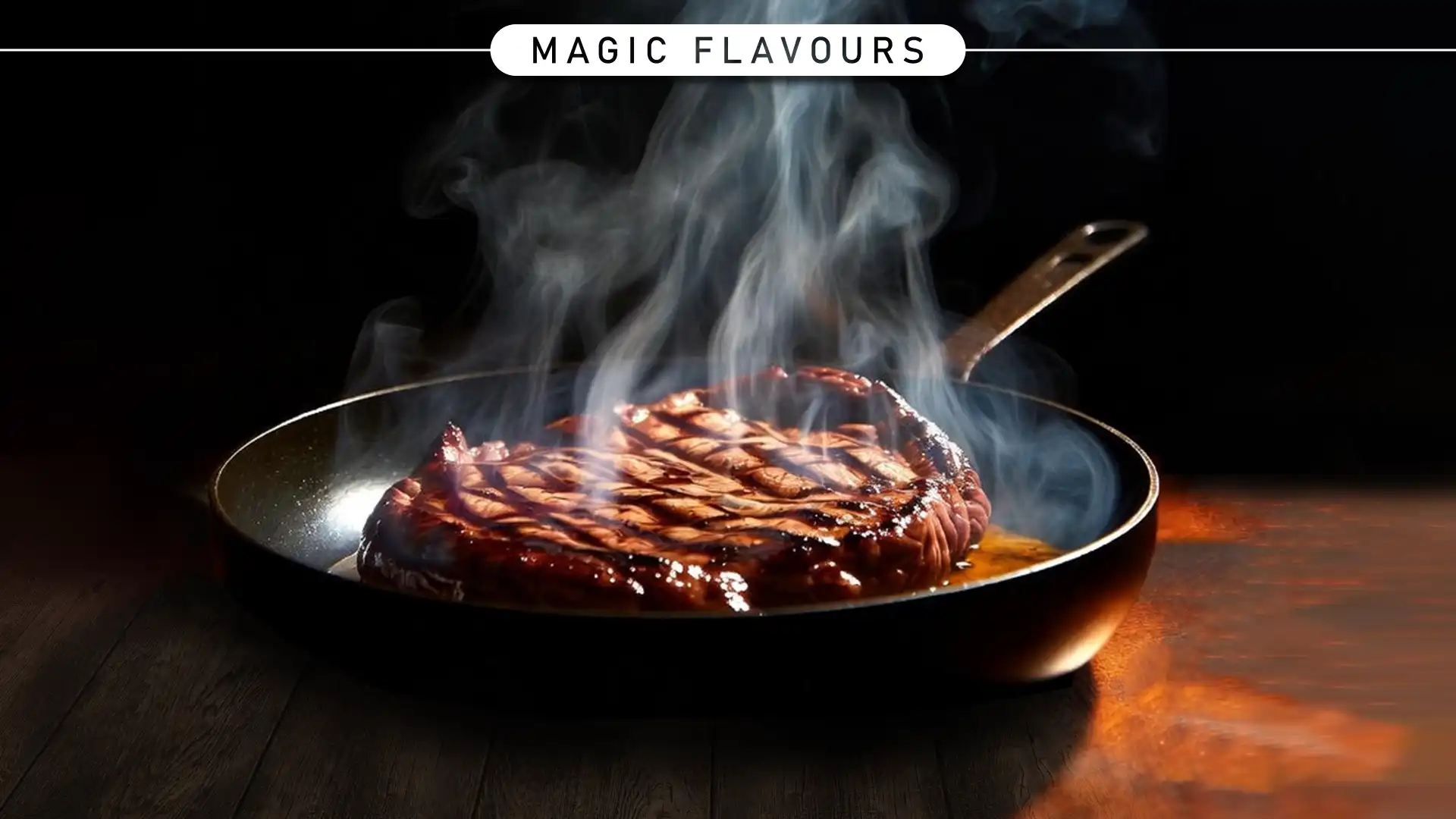1. Introduction: Why Reaction Flavor Matters
The sizzle of a grill. The golden crust on bread. The smoky depth of roasted spices. These aren’t just culinary moments—they’re chemical masterpieces. At their core lies reaction flavor: the transformation of simple ingredients into extraordinary taste through heat, time, and molecular magic.
In today’s food industry, flavor isn’t just sensory—it’s strategic. Whether developing plant-based proteins, enhancing snacks, or creating clean-label solutions, reaction flavor builds emotional connection, drives loyalty, and helps brands stand out.
As consumers demand authenticity and excitement, brands must move beyond surface taste. Reaction flavors deliver layered complexity—notes that spark memory, culture, and craveability.
This article explores the science, sensory impact, and strategic value of reaction flavor. From Maillard to caramelization, fermentation to lipid oxidation, we’ll show how these reactions shape not only taste—but trust.
2. What Is Reaction Flavor?
At its simplest, reaction flavor refers to the taste and aroma compounds created when ingredients undergo chemical changes—especially during cooking, heating, or fermentation. These reactions unlock hidden dimensions of flavor, transforming bland or raw materials into rich, complex, and emotionally resonant experiences.
Unlike added flavorings or extracts, reaction flavors are born from interaction. They emerge when proteins meet sugars, when fats oxidize, or when microbes ferment. The result? Notes that evoke roasting, browning, aging, or tangy depth—often impossible to achieve through direct flavor addition alone.
There are two key categories to consider:
2.1 Natural Reaction Flavors
These occur organically during traditional processes like baking, grilling, or fermenting. They’re shaped by time, temperature, and ingredient composition.
2.2 Engineered Reaction Flavors

Created through controlled reactions in flavor labs, these mimic the sensory impact of natural processes. They’re especially valuable in plant-based, low-fat, or clean-label formulations where traditional reactions may be limited or absent.
In both cases, reaction flavor is more than chemistry—it’s craftsmanship. It’s the art of turning transformation into taste.
3. The Science Behind Flavor Reactions
Flavor isn’t just added—it’s created. Through heat, time, and molecular interaction, ingredients undergo transformations that unlock new sensory dimensions. These reactions are the backbone of reaction flavor, and they’re responsible for the roasted, toasted, aged, and umami-rich notes we crave.
Let’s explore the key players:
3.1 Maillard Reaction: The Backbone of Savory
When amino acids meet reducing sugars under heat, the Maillard reaction begins. It’s responsible for the browned crust on bread, the seared edge of steak, and the deep aroma of roasted coffee.
- Flavor notes: Meaty, nutty, roasted, umami
- Applications: Grilled meats, baked goods, coffee, alt-protein flavor systems
- Challenges: Replicating Maillard depth in plant-based matrices due to protein structure and sugar availability
Moreover, Maillard reactions are highly sensitive to pH, moisture, and temperature—making them a playground for flavor engineers.
3.2 Caramelization: Sweet Complexity in Reaction Flavor

Unlike Maillard, caramelization involves the breakdown of sugars alone. As sugars heat, they dehydrate and fragment, forming hundreds of compounds that deliver sweet, nutty, and slightly bitter notes.
- Flavor notes: Buttery, toasty, burnt sugar
- Applications: Confectionery, sauces, roasted vegetables, dairy analogs
- Opportunities: Enhancing indulgence while reducing added sugar
In fact, caramelization can be used strategically to build depth in savory formulations—especially when paired with umami-rich bases.
3.3 Lipid Oxidation: A Double-Edged Sword in Reaction Flavor
When fats oxidize, they produce volatile compounds that can either enhance flavor or trigger off-notes. Controlled oxidation contributes to aged cheese, cured meats, and certain snack profiles.
- Flavor notes: Aged, creamy, sometimes metallic or rancid
- Applications: Cheese, nuts, dairy, savory snacks
- Risks: Uncontrolled oxidation leads to instability and sensory rejection
Therefore, managing oxidation is critical—not just for shelf life, but for flavor integrity.
3.4 Fermentation & Enzymatic Reactions: Microbial Magic
Fermentation introduces acids, esters, and alcohols that add tang, funk, and umami. Enzymatic reactions, meanwhile, break down proteins and fats to release flavor precursors.
- Flavor notes: Tangy, funky, umami, sour
- Applications: Yogurt, soy sauce, sourdough, plant-based cheeses
- Cultural relevance: Anchors flavor in tradition and regional identity
Just like Maillard, these reactions are deeply influenced by time, temperature, and microbial strain—making them ideal for customization.
4. Reaction Flavor in Plant-Based and Alt-Protein Products
Creating craveable flavor in plant-based foods is no longer optional—it’s essential. As consumers seek meatless options that deliver on taste, texture, and emotional satisfaction, reaction flavor becomes a critical tool for authenticity and differentiation.
However, replicating the depth of grilled meat or aged cheese in plant matrices presents unique challenges.
4.1 The Challenge: Reaction Flavor Chemistry Without the Canvas
Traditional reaction flavors rely on animal-derived proteins, fats, and sugars to trigger Maillard, lipid oxidation, and enzymatic reactions. In plant-based systems:
- Protein structures differ, affecting reaction pathways
- Sugars may be limited or bound, reducing browning potential
- Off-notes from legumes or grains can interfere with desired profiles
Because of this, flavor developers must rethink how to build savory, roasted, and umami notes from the ground up.
4.2 The Strategy: Layering, Masking, and Mimicry

To overcome these barriers, formulators use a combination of techniques:
- Custom reaction flavor systems designed for plant proteins
- Precursors and enhancers that simulate Maillard or lipid-derived notes
- Masking agents to neutralize beany or grassy undertones
- Fermentation and enzymatic processing to unlock depth and complexity
In addition, pairing reaction flavors with fat mimetics or umami boosters can amplify mouthfeel and satisfaction.
4.3 The Opportunity: Emotionally Authentic Flavor
Ultimately, the goal isn’t just to mimic meat—it’s to create a sensory experience that feels familiar, comforting, and exciting. Reaction flavor helps bridge the gap between expectation and innovation, turning plant-based products into emotional favorites.
Whether it’s smoky barbecue, buttery caramel, or aged umami, reaction flavor gives plant-based brands the power to surprise, delight, and retain.
5. Sensory Experience and Consumer Perception
Flavor isn’t just tasted. Instead, it is felt, remembered, and emotionally interpreted. In addition, reaction flavors play a key role in shaping how consumers perceive quality, authenticity, and indulgence. Finally, they are the invisible storytellers behind every satisfying bite.
5.1 The Power of Taste Memory

When a consumer bites into a grilled burger or sips a roasted coffee, they’re not just registering flavor—they’re recalling moments. Reaction flavors trigger taste memories linked to comfort, celebration, or cultural identity.
- Roasted notes evoke warmth and nostalgia
- Caramelized sweetness signals indulgence and reward
- Umami depth suggests richness and satisfaction
Because of this, reaction flavors can elevate even simple formulations into emotionally resonant experiences.
5.2 Emotional Resonance and Brand Loyalty of
Reaction Flavor
Products that deliver consistent, craveable reaction flavors often become favorites—not just for their taste, but for how they make consumers feel. This emotional resonance drives:
- Repeat purchase behavior
- Positive word-of-mouth
- Perceived value and premium positioning
Indeed, flavor is one of the most powerful tools for building brand loyalty—especially when it feels authentic and layered.
5.3 Cross-Cultural Expectations and Sensory Nuance
Flavor preferences vary across regions, but reaction flavors offer a universal language of deliciousness. Still, nuance matters:
- Smoky depth may signal luxury in one market, but harshness in another
- Fermented tang may be prized in East Asia, but polarizing elsewhere
- Sweet-roasted profiles often appeal globally, but require balance
Therefore, tailoring reaction flavor systems to cultural expectations is key to global success.
6. Health, Clean Label, and Regulatory Considerations of
Reaction Flavor
As consumers become more ingredient-conscious, reaction flavor must do more than taste good—it must align with evolving expectations around health, transparency, and safety.
Fortunately, when used strategically, reaction flavor can enhance nutritional profiles while supporting clean-label claims.
6.1 Reducing Salt, Sugar, and Fat—Without Compromise
Reaction flavors offer a powerful way to maintain indulgence while reducing less desirable ingredients:
- Maillard-derived savory notes can replace or reduce added salt
- Caramelized compounds deliver sweetness and depth with less sugar
- Lipid oxidation and fermentation can mimic richness without added fat
Because of this, reaction flavor becomes a functional tool—not just a sensory one.
6.2 Navigating Natural Claims and Labeling of
Reaction Flavor
Consumers increasingly seek “natural” and “clean” labels, but reaction flavors occupy a nuanced space:
- Naturally occurring reactions (e.g., baking, roasting) are widely accepted
- Engineered reaction flavors may require specific labeling, depending on jurisdiction
- Flavor precursors and enhancers must be declared transparently
It’s worth noting that regulatory definitions of “natural” vary by region, making global compliance a strategic consideration.
6.3 Safety, Stability, and Shelf Life of Reaction Flavor
While reaction flavors are generally safe, their complexity demands careful formulation:
- Some compounds may degrade or interact over time
- Oxidation pathways must be controlled to avoid rancidity
- Fermented notes require microbial stability and pH management
Therefore, working with experienced flavor partners is essential to ensure both sensory impact and product integrity.
7. Innovation Opportunities for B2B Brands
In a market flooded with options, flavor is no longer just a differentiator. Instead, it is a declaration. Moreover, reaction flavor gives B2B brands the chance to move beyond generic taste. It also opens the door to emotional, cultural, and functional storytelling.
7.1 Custom Flavor Systems for Regional Markets

Reaction flavor can be tailored to reflect regional preferences and culinary traditions:
- Smoky depth for Middle Eastern grilled profiles
- Fermented tang for East Asian umami-rich dishes
- Sweet-roasted notes for Western indulgent snacks
By engineering reaction flavor systems that resonate locally, brands can create products that feel familiar yet exciting.
7.2 Enhancing Blendability and Masking Off-Notes
Reaction flavors are powerful tools for improving formulation performance:
- Blend seamlessly with plant proteins, dairy analogs, or botanical extracts
- Mask bitterness, beany notes, or metallic aftertastes
- Support clean-label claims by reducing reliance on artificial additives
In addition, reaction flavors help stabilize sensory profiles during shelf life and under varying processing conditions.
7.3 Sample-Driven Campaigns and Sensory Storytelling
Flavor is best experienced—not just described. B2B brands can leverage reaction flavor in:
- Sample kits that showcase transformation (e.g., before/after heating)
- Sensory workshops that highlight emotional impact
- Story-rich content that connects flavor to culture, memory, and mood
Ultimately, reaction flavor becomes a narrative tool—one that invites curiosity, builds trust, and drives engagement.
8. Conclusion: Reaction Flavor as a Strategic Asset

First, reaction flavor isn’t just chemistry. Instead, it is a brand experience. Next, it turns a product from satisfying to unforgettable. Finally, from the first bite to the final memory, reaction flavors influence how consumers feel, remember, and repurchase.
In today’s world of clean labels, plant-based innovation, and global competition, flavor must go beyond taste. It must tell a story, solve a problem, and spark emotion.
For B2B brands, flavor is not an afterthought. Instead, it is a strategic lever that shapes formulation, marketing, and loyalty. Moreover, whether launching alt-protein, refreshing a legacy product, or entering new markets, reaction flavor adds depth, authenticity, and delight.
Therefore, the most successful brands will not just follow trends. Instead, they will create them. Moreover, they will use reaction flavor to bridge science and soul, tradition and innovation, function and feeling.
Ready to turn heat into heart? Let’s co-create your next craveable innovation.
